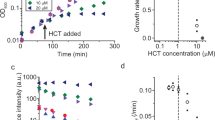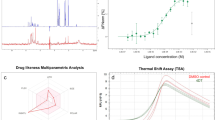Abstract
Careful regulation of mRNA half-lives is a fundamental mechanism allowing cells to quickly respond to changing environmental conditions. The mRNA-binding Hu proteins are important for stabilization of short-lived mRNAs. Here we describe the identification and mechanistic characterization of the first low-molecular-weight inhibitors for Hu protein R (HuR) from microbial broths (Actinomyces sp.): dehydromutactin (1), MS-444 (2) and okicenone (3). These compounds interfere with HuR RNA binding, HuR trafficking, cytokine expression and T-cell activation. A mathematical and experimental analysis of the compounds' mode of action suggests that HuR homodimerizes before RNA binding and that the compounds interfere with the formation of HuR dimers. Our results demonstrate the chemical drugability of HuR; to our knowledge HuR is the first example of a drugable protein within the Hu family. MS-444, dehydromutactin and okicenone may become valuable tools for studying HuR function. An assessment of HuR inhibition as a central node in malignant processes might open up new conceptual routes toward combatting cancer.
This is a preview of subscription content, access via your institution
Access options
Subscribe to this journal
Receive 12 print issues and online access
$259.00 per year
only $21.58 per issue
Buy this article
- Purchase on Springer Link
- Instant access to full article PDF
Prices may be subject to local taxes which are calculated during checkout







Similar content being viewed by others
Accession codes
References
Bakheet, T., Williams, B.R. & Khabar, K.S. ARED 3.0: the large and diverse AU-rich transcriptome. Nucleic Acids Res. 34, D111–D114 (2006).
López de Silanes, I., Lal, A. & Gorospe, M. HuR - posttranscriptional paths to malignancy. RNA Biol. 2, e11–e13 (2005).
López de Silanes, I. et al. Role of the RNA-binding protein HuR in colon carcinogenesis. Oncogene 22, 7146–7154 (2003).
Erkinheimo, T.L. et al. Cytoplasmic HuR expression correlates with epithelial cancer cell but not with stromal cell cyclooxygenase-2 expression in mucinous ovarian carcinoma. Gynecol. Oncol. 99, 14–19 (2005).
Mrena, J. et al. Prognostic significance of cyclin A in gastric cancer. Int. J. Cancer 119, 1897–1901 (2006).
Erkinheimo, T.L. et al. Cytoplasmic HuR expression correlates with poor outcome and with cyclooxygenase 2 expression in serous ovarian carcinoma. Cancer Res. 63, 7591–7594 (2003).
Denkert, C. et al. Overexpression of the embryonic-lethal abnormal vision-like protein HuR in ovarian carcinoma is a prognostic factor and is associated with increased cyclooxygenase 2 expression. Cancer Res. 64, 189–195 (2004).
Denkert, C. et al. Expression of the ELAV-like protein HuR is associated with higher tumor grade and increased cyclooxygenase-2 expression in human breast carcinoma. Clin. Cancer Res. 10, 5580–5586 (2004).
Dalmau, J., Furneaux, H.M., Cordon-Cardo, C. & Posner, J.B. The expression of the Hu (paraneoplastic encephalomyelitis/sensory neuronopathy) antigen in human normal and tumor tissues. Am. J. Pathol. 141, 881–886 (1992).
Dalmau, J., Furneaux, H.M., Rosenblum, M.K., Graus, F. & Posner, J.B. Detection of the anti-Hu antibody in specific regions of the nervous system and tumor from patients with paraneoplastic encephalomyelitis/sensory neuronopathy. Neurology 41, 1757–1764 (1991).
Wilkinson, P.C. & Zeromski, J. Immunofluorescent detection of antibodies against neurones in sensory carcinomatous neuropathy. Brain 88, 529–583 (1965).
Voltz, R. Paraneoplastic neurological syndromes: an update on diagnosis, pathogenesis, and therapy. Lancet Neurol. 1, 294–305 (2002).
Liu, J. et al. Paraneoplastic encephalomyelitis antigens bind to the AU-rich elements of mRNA. Neurology 45, 544–550 (1995).
Datta, K. et al. Role of elongin-binding domain of von hippel lindau gene product on HuR-mediated VPF/VEGF mRNA stability in renal cell carcinoma. Oncogene 24, 7850–7858 (2005).
Heinonen, M. et al. Cytoplasmic HuR expression is a prognostic factor in invasive ductal breast carcinoma. Cancer Res. 65, 2157–2161 (2005).
Carlsson, A. & Schwartz, S. Inhibitory activity of the human papillomavirus type 1 AU-rich element correlates inversely with the levels of the elav-like HuR protein in the cell cytoplasm. Arch. Virol. 145, 491–503 (2000).
Denkert, C. et al. Expression of the ELAV-like protein HuR in human colon cancer: association with tumor stage and cyclooxygenase-2. Mod. Pathol. 19, 1261–1269 (2006).
Zhang, J.H., Chung, T.D.Y. & Oldenburg, K.R. A simple statistical parameter for use in evaluation and validation of high throughput screening assazs. J. Biomol. Screen. 4, 67–73 (1999).
Meisner, N.C. et al. mRNA openers and closers: modulating AU-rich element-controlled mRNA stability by a molecular switch in mRNA secondary structure. ChemBioChem 5, 1432–1447 (2004).
Maris, C., Dominguez, C. & Allain, F.H. The RNA recognition motif, a plastic RNA-binding platform to regulate post-transcriptional gene expression. FEBS J. 272, 2118–2131 (2005).
Dean, J.L.E. et al. The 3′-untranslated region of tumor necrosis factor α mRNA is a target of the mRNA-stabilizing factor HuR. Mol. Cell. Biol. 21, 721–730 (2001).
Kasashima, K., Sakashita, E., Saito, K. & Sakamoto, H. Complex formation of the neuron-specific ELAV-like Hu RNA-binding proteins. Nucleic Acids Res. 30, 4519–4526 (2002).
Huang, C.Y. Determination of binding stoichiometry by the continuous variation method: the Job plot. Methods Enzymol. 87, 509–525 (1982).
Gallouzi, I.E. & Steitz, J.A. Delineation of mRNA export pathways by the use of cell-permeable peptides. Science 294, 1895–1901 (2001).
Wang, W., Caldwell, C., Lon, S., Furneaux, H. & Gorospe, M. HuR regulates cyclin A and cyclin B1 mRNA stability during cell proliferation. EMBO J. 19, 2340–2350 (2000).
Wang, W. et al. HuR regulates p21 mRNA stabilization by UV light. Mol. Cell. Biol. 20, 760–769 (2000).
Lal, A., Kawai, T., Yang, X., Mazan-Mamczarz, K. & Gorospe, M. Antiapoptotic function of RNA-binding protein HuR effected through prothymosin alpha. EMBO J. 24, 1852–1862 (2005).
Goldberg-Cohen, I., Furneauxb, H. & Levy, A.P. A 40-bp RNA element that mediates stabilization of vascular endothelial growth factor mRNA by HuR. J. Biol. Chem. 277, 13635–13640 (2002).
Sheflin, L.G., Zou, A.P. & Spaulding, S.W. Androgens regulate the binding of endogenous HuR to the AU-rich 3′UTRs of HIF-1α and EGF mRNA. Biochem. Biophys. Res. Commun. 322, 644–651 (2004).
Huwiler, A. et al. ATP potentiates interleukin-1 beta-induced MMP-9 expression in mesangial cells via recruitment of the ELAV protein HuR. J. Biol. Chem. 278, 51758–51769 (2003).
Tran, H., Maurer, F. & Nagamine, Y. Stabilization of urokinase and urokinase receptor mRNAs by HuR is linked to its cytoplasmic accumulation induced by activated mitogen-activated protein kinase-activated protein kinase 2. Mol. Cell. Biol. 23, 7177–7188 (2003).
Tatsuta, K., Nakanishi, S. & Takahashi, I. Preparation of MS-444 derivatives as immunosuppressive and anti-itching agents. WO patent 9832750 (1997).
Snider, B.B. & Zhang, Q. Synthesis of (+-)-okicenone and (+-)-aloesaponol III. J. Org. Chem. 58, 3185–3187 (1993).
Torigoe, K., Nakajima, S., Suzuki, H., Ojiri, K. & Suda, H. Antitumoric BE-34776 manufacture with Micromonospora. JP patent 06256338 (1994).
Nakanishi, S., Chiba, S., Yano, H., Kawamoto, I. & Matsuda, Y. MS-444, a new inhibitor of myosin light chain kinase from Micromonospora sp. KY7123. J. Antibiot. (Tokyo) 48, 948–951 (1995).
Tatsuta, K., Yoshimoto, T. & Gunji, H. Total synthesis of MS-444, a myosin light chain kinase inhibitor. J. Antibiot. (Tokyo) 50, 289–290 (1997).
McDaniel, R., Ebert-Khosla, S., Fu, H., Hopwood, D.A. & Khosla, C. Engineered biosynthesis of novel polyketides: influence of a downstream enzyme on the catalytic specificity of a minimal aromatic polyketide synthase. Proc. Natl. Acad. Sci. USA 91, 11542–11546 (1994).
Giannini, G. et al. Chrysanthones, a new source of fungal metabolites with potential antitumor and antiangiogenesis properties. Fitoterapia 74, 323–327 (2003).
Yano, H., Nakanishi, S., Matsuda, Y., Nonomura, Y. & Sasaki, H. Anti-HIV drug. WO patent 9405283 (1993).
Kask, P. et al. Two-dimensional fluorescence intensity distribution analysis: theory and applications. Biophys. J. 78, 1703–1713 (2000).
Kask, P., Palo, K., Ullmann, D. & Gall, K. Fluorescence-intensity distribution analysis and its application in biomolecular detection technology. Proc. Natl. Acad. Sci. USA 96, 13756–13761 (1999).
Acknowledgements
The authors thank R. Amstutz and J.E. DeVries for continuous support, and P. Fürst for reviewing the manuscript. This work was supported by a scholarship from the Austrian Academy of Sciences.
Author information
Authors and Affiliations
Contributions
N.-C.M. and V.U. established the screening assay. J.O. performed the high-throughput screen. L.O., C.G., S.M. and H.-U.N. isolated the compounds and elucidated the structures. N.-C.M. and M.H. performed the compound selection and mechanistic compound characterization. M.H. assessed structure-related literature information. J.-M.S. was responsible for the analytics and reagent preparation. N.-C.M. and J.-M.S. performed the microdialysis experiments. C.B. was responsible for the instrumental setup for confocal imaging experiments, which were performed by N.-C.M. and R.B. N.H. performed the cytokine expression experiments. The project was designed and coordinated by N.-C.M. and M.A. N.-C.M., M.H. and M.A. wrote the manuscript. All authors discussed the results and commented on the manuscript.
Corresponding authors
Ethics declarations
Competing interests
All authors are employed by Novartis Institutes for Biomedical Research. K.M. was employed by Novartis but is now retired.
Supplementary information
Supplementary Text and Figures
Supplementary Figures 1–6, Supplementary Table 1 and Supplementary Methods (PDF 2782 kb)
Rights and permissions
About this article
Cite this article
Meisner, NC., Hintersteiner, M., Mueller, K. et al. Identification and mechanistic characterization of low-molecular-weight inhibitors for HuR. Nat Chem Biol 3, 508–515 (2007). https://doi.org/10.1038/nchembio.2007.14
Received:
Accepted:
Published:
Issue Date:
DOI: https://doi.org/10.1038/nchembio.2007.14
This article is cited by
-
MUC16 promotes triple-negative breast cancer lung metastasis by modulating RNA-binding protein ELAVL1/HUR
Breast Cancer Research (2023)
-
A TRIM21-based bioPROTAC highlights the therapeutic benefit of HuR degradation
Nature Communications (2023)
-
CMTM6 as a master regulator of PD-L1
Cancer Immunology, Immunotherapy (2022)
-
Mechanistic insights into HuR inhibitor MS-444 arresting embryonic development revealed by low-input RNA-seq and STORM
Cell Biology and Toxicology (2022)
-
Inhibition of the RNA Regulator HuR by SRI-42127 Attenuates Neuropathic Pain After Nerve Injury Through Suppression of Neuroinflammatory Responses
Neurotherapeutics (2022)



